The military prowess of the French is well known throughout the world. What is less well known, is that the French have always been excellent managers of their economy. Ever since Paris was founded, the French economic council has made very precise calculations to make sure all cities in the Empire would have the highest rate of production, the highest commercial output and the fastest population growth possible.
With the advent of writing and mathematics, the French started keeping very precise records of everything they did. Many of these records have survived to the present day. Below, we will take a closer look at how the economy of Paris was managed from 190AD to 410AD.
Nowadays, Paris has grown into a very large city, with a significant commercial and productive capacity. But in the late ancient age, Paris was mostly responsible for sending out new settling parties and worker crews. Because settlers and workers would almost continuously leave Paris, the city never grew very large until much later in its history.
On the other hand, the economic council had determined that more citizens yielded a higher production rate, so efforts were made to keep Paris's population as high as possible without hampering France's territorial expansion.
In 190AD, Paris had a population of 220,000. Because of the fertile farmland surrounding the city, and especially with all the cattle farms, Parisian farmers could produce enough food for the city to grow very quickly. In fact, more food could be produced than the people of Paris could consume, so the city of Bailli received the surplus during this time. The production capacity of Paris was sufficient to equip an entire crew of a thousand workers in as little as 20 years.
By 210AD, that worker crew had been sent out, so the population of Paris had shrunk somewhat. Bailli no longer received the surplus food, so Paris could grow faster than before. In another 20 years, Paris would reach the same population as in 190AD. As the city grew, production capacity would also grow again, allowing the city to finish equipping another crew of workers.
Over the next 20 years, starting in 230AD, surplus food production was sent towards Bailli again, and then reduced even further by having some citizens work in the desert mines north of Paris, so that a new settler party could be equipped in a very short period of time.
That additional production was only required for a short period, because Paris would soon grow again, giving it a more sustainable production capacity in the form of additional population. So starting from 250AD, food production was increased again, at the loss of only a little production.
In 260AD, the citizens of Paris continued to work as before, and so the city grew again, adding even more production to finish equipping the settlers.
In 270AD, after the settler party had been sent out, Paris had only 110,000 citizens left. The mines near Mont des Dieux were now no longer worked, so production had dropped significantly. On the other hand, there were less mouths to feed now, so the ample food production would lead to even more rapid population growth. In fact, Bailli could now also grow at a continuously fast pace, after producing the settling party that would found Bananes.
In 280AD, Paris was about to grow again, and would again additional production from the desert mines. There was no use in keeping the Mont des Dieux mines available, because the food that could be harvested there wouldn't arrive in time to feed any of the Parisian citizens.
In 290AD, during a short period of time, additional production capacity was required in Paris. Quentin gave up some of its land to provide that capacity, while Bovin in turn gave up some land for Quentin. Because Paris would again grow soon enough, this was only a temporary measure. It also allowed some of the citizens of Bovin to concentrate on research, so that the knowledge of Polytheism would be known sooner than expected (see chapter 27 to note the sudden acceleration in research).
By 300AD, Paris had almost reached its starting population, and would finish equipping a settling party at the same time. Because of the production capacity that was about to be added, some of the citizens could return to the ancient fishing activities that had made Paris the commercial center of the world shortly after its founding. Even now, the additional commerce made a big difference, adding about 25% to Paris' commercial output.
As the settler party was sent out, Paris found itself in the same state as 40 years before. Starting in 310AD, the same process was initiated again, to produce another settling party by the end of 340AD. The only difference this second time around, was that the cultural borders of Quentin had expanded after the Pentagon had been completed, so Quentin and Bovin had enough land to put all their citizens to work, even when Paris required extra production.
So, in 350AD, Paris was again at a population of 110,000 citizens, and a settling party was headed for Aztec territory, to replace Tzintzuntzen, the Aztec town that was to be destroyed very soon. The French military would need some time to reposition after that, and more roads would have to be built. With the expansion of the empire, more workers would be needed anyway. So it was decided that Paris would be left to grow again, so that workers could be equipped faster. During this period of growth, two divisions of spearmen would be trained and equipped.
In 360AD, more efforts could be dedicated to support the economy and the last part of research on Currency. Quentin citizens worked the Champs de Mars, freeing up land in Épices, which in turn freed up land for Bailli.
As the years passed, Paris's population steadily grew again, especially since no settlers or workers left the city. The first division of spearmen was almost ready.
In 380AD, Paris was again about to gain additional production capacity, as a sufficient number of citizens would become available to go work in the mines of the Desert des Ancêtres (not marked in the picture this time). That additional production would suffice to provide half of the weapons needed by the second division of spearmen.
Starting in 390AD, Paris required some military police again, because people were starting to feel crowded. The second and last spearmen division would be ready in time to relieve the swordsmen that had moved in from Ancêtres. The swordsmen could then move on towards the front.
In 400AD, Paris was in the last phase of the development cycle we've been reviewing in this chapter. A worker party would be readied again.
In 410AD, we see exactly the same view as in 190AD. Two more worker parties will be equipped, and many more settler parties after that. By this time, the Korean settlements in the north had been destroyed, and the northern army was preparing to turn to the Egyptians. Additional settlers would be required in the south as well. Paris and France were thriving.





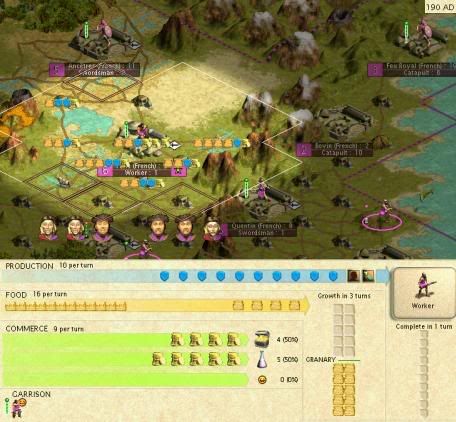



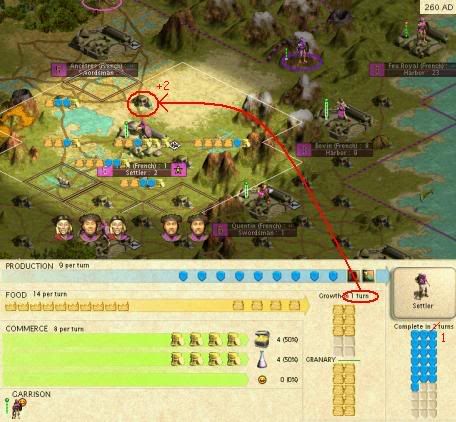


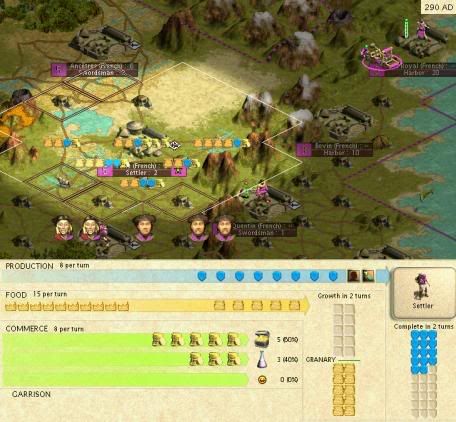



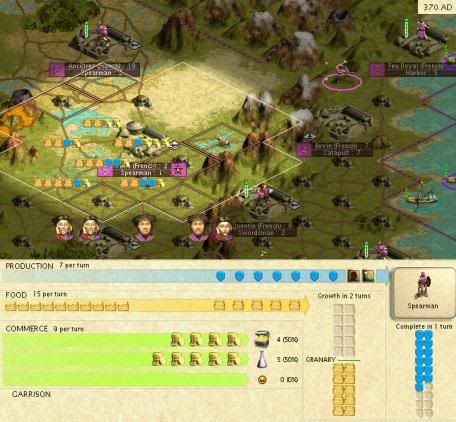


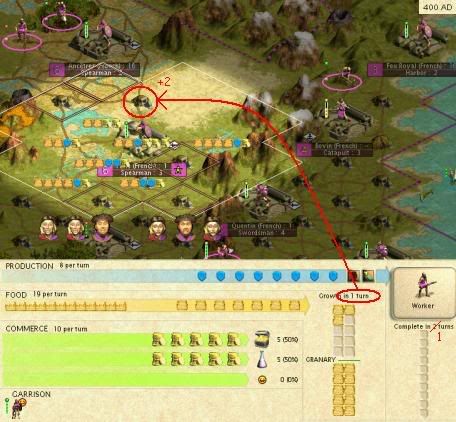

 . I use various sizes and weights depending on the situation.
. I use various sizes and weights depending on the situation. Strangness...
Strangness...